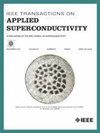Effect of LN2 Sloshing on the Lateral Dynamic of HTS Pinning Maglev
IF 1.7
3区 物理与天体物理
Q3 ENGINEERING, ELECTRICAL & ELECTRONIC
引用次数: 0
Abstract
As an innovative maglev system, the high-temperature superconducting (HTS) pinning magnetic levitation (maglev) train achieves levitation and guidance through the interaction between the HTS bulks in the levitator and the permanent magnet guideway. To ensure that the HTS pinning maglev maintains a stable levitation working state, the ambient temperature of the HTS bulk must remain below its critical temperature. The current method is injecting liquid nitrogen (LN 2 ) into the levitator's liquid tank for cooling. However, due to heat transfer, LN 2 in the tank is not always fully replenished. External disturbances can cause LN 2 sloshing, which affects the vehicle's dynamic performance. This issue remains underexplored by scholars. In this article, LN 2 excitation is integrated into studying the dynamic performance of HTS pinning maglev for the first time. First, a spring–mass model is established to deal with the LN 2 sloshing in the levitator equivalently. Computational fluid dynamics software verifies the feasibility of this model. The equivalent model is then integrated into the vehicle system to develop an HTS pinning vehicle dynamics model, which is validated by experimental data. Subsequently, the dynamic response of the vehicle and the levitators considering the LN 2 sloshing is analyzed. Finally, the optimal LN 2 filling ratio in the levitator is proposed from the perspective of dynamic performance optimization. The results show that the LN 2 sloshing in the levitator has a particular influence on the lateral vibration, lateral displacement, and roll angle of the HTS pinning maglev vehicle. In addition, it is recommended to replenish LN 2 when the filling ratio inside the levitator reaches 70%. This work enhances the understanding of the dynamic response of HTS pinning maglev trains under multiple excitations and provides a reference for refining HTS pinning maglev modeling.LN2 Sloshing 对 HTS 引脚式磁悬浮侧向动力的影响
作为一种创新型磁悬浮系统,高温超导引脚磁悬浮列车通过悬浮器中的高温超导块体与永磁导轨之间的相互作用实现悬浮和制导。为确保 HTS 引脚磁悬浮保持稳定的悬浮工作状态,HTS 体块的环境温度必须保持在临界温度以下。目前的方法是向悬浮器的液体槽中注入液氮(LN2)进行冷却。然而,由于热传导的原因,液氮罐中的 LN2 并不总能得到充分补充。外部干扰会导致 LN2 喷射,从而影响飞行器的动态性能。学者们对这一问题的研究仍然不足。本文首次将 LN2 激励纳入 HTS 销磁磁悬浮的动态性能研究。首先,建立了一个弹簧-质量模型,以等效处理悬浮器中的 LN2 悬浮现象。计算流体动力学软件验证了该模型的可行性。然后将等效模型集成到飞行器系统中,开发出 HTS 引脚飞行器动力学模型,并通过实验数据进行验证。随后,分析了考虑到 LN2 悬浮的飞行器和悬浮器的动态响应。最后,从动态性能优化的角度提出了悬浮器中的最佳 LN2 填充比。结果表明,悬浮器中的 LN2 悬浮对 HTS 销轴磁悬浮列车的横向振动、横向位移和滚动角有特别大的影响。此外,建议在悬浮器内填充率达到 70% 时补充 LN2。这项研究加深了人们对多重激励下 HTS 引脚式磁悬浮列车动态响应的理解,为完善 HTS 引脚式磁悬浮建模提供了参考。
本文章由计算机程序翻译,如有差异,请以英文原文为准。
求助全文
约1分钟内获得全文
求助全文
来源期刊

IEEE Transactions on Applied Superconductivity
工程技术-工程:电子与电气
CiteScore
3.50
自引率
33.30%
发文量
650
审稿时长
2.3 months
期刊介绍:
IEEE Transactions on Applied Superconductivity (TAS) contains articles on the applications of superconductivity and other relevant technology. Electronic applications include analog and digital circuits employing thin films and active devices such as Josephson junctions. Large scale applications include magnets for power applications such as motors and generators, for magnetic resonance, for accelerators, and cable applications such as power transmission.
 求助内容:
求助内容: 应助结果提醒方式:
应助结果提醒方式:


